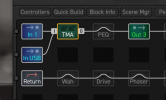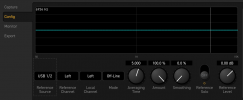Insert the TMA block at the begininng of your FX chain, after the input block. Also insert a In USB block (as in the picture above)
The TMA block has two switches: Start Reference and Start Local
Start Reference is used for capturing the tonematched guitar by playing the wav file from the DAW (use the Axe-FX "In U Block L" as Output device)
Start Local is used for capturing your guitar (source guitar) either by directly playing the chromatic scale as described above or, more conveniently, from a DAW recording of your guitar.
Once finished capturing, press the Match button and adjust the Smoothing. Also adjust the Averaging Time, as singtail has suggested
When you save the preset, the tonematch will be saved with it. You can save the TMA block to use at other presets or export it as IR
Keep in mind that the preset or the exported IR will only bring good results with the guitar that you have used as Local for tonemaching. If you want to use it with other guitar or if you want to share it, the TM process has to be repeated with the new source guitar
Have a look to the
Axe-FX Tone Matching Mini Manual and the TMA section of the user manual for more details. There are some tutorials at YouTube from Leon and Cooper Carter


